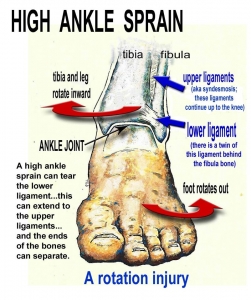What is an ankle sprain?
An ankle sprain refers to tearing of the ligaments of the ankle. The most common ankle sprain occurs on the lateral or outside part of the ankle. This is an extremely common injury which affects many people during a wide variety of activities. It can happen in the setting of an ankle fracture (i.e. when the bones of the ankle also break). Most commonly, however, it occurs in isolation.
What are the symptoms an ankle sprain?
Patients report pain after having twisted an ankle. This usually occurs due to an inversion injury, which means the foot rolls underneath the ankle or leg. It commonly occurs during sports. Patients will complain of pain on the outside of their ankle and various degrees of swelling and bleeding under the skin (i.e. bruising). Technically, this bruising is referred to as ecchymosis. Depending on the severity of the sprain, a person may or may not be able to put weight on the foot.
Anatomy
There are multiple ligaments in the ankle. Ligaments in general are those structures that connect bone-to-bone. Tendons, on the other hand, connect muscle-to-bone and allow those muscles to exert their force. In the case of an ankle sprain, there are several commonly sprained ligaments.
How is an ankle sprain diagnosed?
Ankle sprains can be diagnosed fairly easily given that they are common injuries. The location of pain on the outside of the ankle with tenderness and swelling in a patient who has an ankle with inversion is very suggestive. In these patients, normal X-rays also suggest that the bone has not been broken and instead the ankle ligaments have been torn or sprained.
It is very important, however, not to simply regard any injury as an ankle sprain because other injuries can occur as well. For example, the peroneal tendons mentioned above can be torn. There can also be fractures in other bones around the ankle including the fifth metatarsal and the anterior process of the calcaneus. In very severe cases, an MRI may be warranted to rule out other problems in the ankle such as damage to the cartilage. An MRI typically is not necessary to diagnose a sprain.
What are treatment options?
Surgery is not required in the vast majority of ankle sprains. Even in severe sprains, these ligaments will heal without surgery. The grade of the sprain will dictate treatment. Sprains are traditionally classified into several grades. Perhaps more important, however, is the patient’s ability to bear weight. Those that can bear weight even after the injury are likely to return very quickly to play. Those who cannot walk may need to be immobilized.
In general, treatment in the first 48 to 72 hours consists of resting the ankle, icing 20 minutes every two to three hours, compressing with an ACE wrap, and elevating, which means positioning the leg and ankle so that the toes are above the level of patient’s nose. Those patients who cannot bear weight are better treated in a removable walking boot until they can comfortably bear weight.
Physical therapy is a mainstay. Patients should learn to strengthen the muscles around the ankle, particularly the peroneals. An ankle brace can be used in an athlete until a therapist believes that the ankle is strong enough to return to play without it. Surgery is rarely indicated but may be needed in a patient who has cartilage damage or other related injuries. Ligaments are only repaired or strengthened in cases of chronic instability in which the ligaments have healed but not in a strong fashion.
For a full assessment please call the clinic on 0404 80005 or email info@energisetherapy.ie

